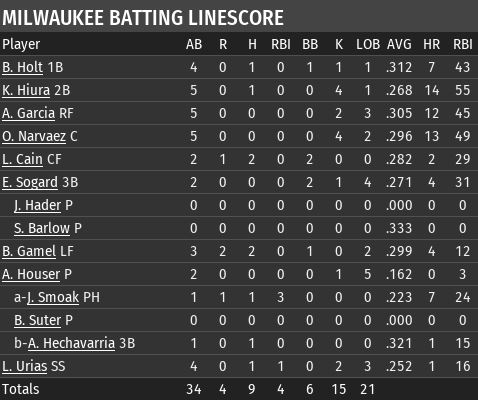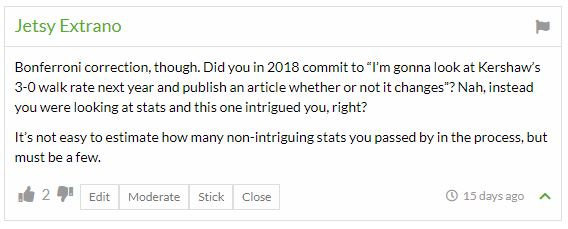FanGraphs Live! Tuesday: OOTP Brewers
Today on FanGraphs Live, let’s grapple with the fact that sometimes Christian Yelich gets hurt. Read the rest of this entry »
Today on FanGraphs Live, let’s grapple with the fact that sometimes Christian Yelich gets hurt. Read the rest of this entry »
You can’t make the postseason in a single day in July. You can’t be eliminated either, of course, even if you’re the valiant Brewers and your opponents are your perennial rivals, those darn St. Louis Cardinals. This past Friday, however, something momentous happened in our OOTP simulation.
Here, take a look at the box score:

So no, it wasn’t a spectacular performance, on either side, that makes this game the rare ultra-meaningful July clash. The 3-2 loss featured more squandered opportunities than you’d generally like to see, including two runners on third left stranded with less than two outs. That’s not really worth a column, though.
The scary part (and there is a scary part) probably jumps right out at you. But just in case, here’s the next day’s box score to drive the point home:

This one was a 4-2 win, keyed by a pinch hit home run from Justin Smoak — first and third, two outs in the top of the sixth, and excellent time to pinch hit. It dropped Jack Flaherty to a woeful 2-11 simulated record — oof. But the key to this game isn’t any of that. It’s Ben Gamel, batting seventh, with a quietly effective day. Read the rest of this entry »
There are plenty of rule changes coming to baseball in the 2020 season. We’ve written about many of them: the universal DH, the extra-innings rule, and expanded rosters, to name a few. Today, I thought I’d take a crack at something less immediately evident but still meaningful: the denser schedule.
In 2019, teams played 162 games in 186 days. That meant the schedule was 13% off days, give or take. Four of them were clustered around the All-Star break, but for the most part, they were spread out evenly. Off days are a welcome respite in a team’s schedule, a break from the grind. Sometimes they’re necessary for travel, of course, but mostly they’re meant just to be time for players to recover from the grueling march to October. This year, 60 games in 66 days means only 9% off days.
For most players, an off day is simply that. For pitchers, however, days of rest carry greater meaning. A day off is a day closer to starting again. Imagine a schedule with 80% off days — a game every five days. Your ace could pitch more or less every game, give or take a maintenance break here and there. Conversely, in a schedule with no off days at all, every pitcher would take the same number of turns in the rotation.
Given an off day, teams can, in theory, squeeze extra starts out of their ace. In practice, it doesn’t quite work that way. It also doesn’t not work that way, however; seven pitchers made 34 starts in 2019, more than a fifth of the games on the schedule. Teams are logical about giving their best starters extra turns when they can. An extra Justin Verlander start beats a Jose Urquidy start, no offense to Urquidy. Read the rest of this entry »
The alternate OOTP universe is now past the halfway point. Today, we’ll take stock of our Brewers, consider a few bullpen moves, and take a look around the league for outstanding performances. Read the rest of this entry »
Last week, an interesting question got me wondering about Billy Hamilton and the new extra-innings rules. As it turns out, he’s a valuable runner to have on second base! So valuable in fact, that he projects to gain his team roughly 0.3 wins in a 60-game season just by being fast.
For the Giants, that’s great. For the other 29 teams in baseball (or 28 if the Dodgers end up rostering Terrance Gore), that’s no help. What should their strategy be in extra innings? I had all these run expectancy tables, so I decided to dive in.
First things first: let’s set the parameters of this discussion. I’m going to be considering two decisions. First, does bunting to lead off the inning make sense, and does that decision change based on whether you’re the home or visiting squad? Second, assuming bunting doesn’t make sense, what about stealing third? Presumably you’d steal with one out, what with not making the first out at third base and all, so we’ll focus on those two decision points: bunting to lead off, and stealing if the first at-bat doesn’t produce any advancement.
The value of being a home team is immediately evident when looked at through this lens. Consider a situation where the visiting team scores two runs in the top of the inning. Right away, a bunt goes out the window. That’s a big edge; in 2019, and excluding extra innings so that walk-offs don’t interrupt a team’s run scoring, teams that reached the position of a runner on second base with no outs scored two or more runs 29.1% of the time.
In other words, nearly a third of the time, bunting the runner over serves no purpose at all; your team will need two or more runs just to tie, so the position of that runner is nearly immaterial. Getting to act after knowing how many runs your opponent scored is huge. Read the rest of this entry »
In the world of Out Of The Park, the day is June 29, and the teams have played roughly 83 baseball games. Real life, of course, is markedly different; the day is the same, but pretty much everything else isn’t. There have been no games, to name one obvious discrepancy. In a month’s time, however, the lines will be blurrier. Real teams will be playing real games, which makes the prospect of following along with a fake baseball team somewhat less exciting.
To that end, I’d like to take today to lay out my future plans for this series, as well as take a quick look at some outstanding performances across the league this year. Let’s handle the outstanding performances first, because they’re more fun: who needs to plan for the future when you can watch hulking sluggers swat dingers left and right?
Why bring up home runs first? Giancarlo Stanton’s superlative season demands it. The Yankees have played 84 games this year, and Stanton’s health has been uncharacteristically excellent; he’s appeared in 83 of them, almost exclusively in left field. More important than his position, however, is his bat:
| Player | PA | AVG | OBP | SLG | wRC+ | K% | BB% | HR | WAR |
|---|---|---|---|---|---|---|---|---|---|
| Giancarlo Stanton | 369 | .305 | .391 | .732 | 184 | 26.6% | 11.9% | 40 | 4.5 |
That’s right: 40 home runs through 84 games. That’s a 77-dinger pace for a full season! The .300 average is mostly a byproduct of the home runs, but not exclusively; when you’re Stanton, getting down to 26.6% strikeouts is actually a big deal. He’s on pace for a season for the ages; not by WAR, necessarily, where his indifferent outfield defense holds him back. Even accounting for that defensive hit, however, his offensive prowess has him on pace for a 9-WAR season. Read the rest of this entry »
When baseball returns next month, it will be a little weird. Not just because of the empty stands, though of course that will be weird too. Not because of the NL DH — despite the bellyaching about the sanctity of the game, baseball with a DH feels more or less the same as baseball without one. No, I’m talking about the new extra innings rule, which will place a runner on second base to start each half inning beyond the ninth.
A runner on second by itself isn’t weird, but having it happen every inning without a leadoff double will definitely take some getting used to. It’s not all dark clouds, however, because weird baseball rules create weird baseball situations. Effectively Wild listener Brett Mobly wrote in about a particularly interesting angle, and via the magic of Ben-to-Ben communication (read: Meg emailed me about it), here we are.
Mobly wondered about a hypothetical that Jeremy Frank posed on Twitter. What if Billy Hamilton comes to the plate with two outs and no one aboard in the bottom of the ninth? Given that the runner who starts on second base is, by rule, the player on the batting team due up last in the batting order, a Hamilton out comes with a huge carrot: the best baserunner in baseball starting the next inning in scoring position. How should that change his behavior at the plate?
We can start by eliminating the extreme scenario of Hamilton purposefully making an out. Even if he were intent on starting the next inning on second base, he could do better by taking a regular at-bat and then simply running until he’s thrown out. Single? Steal second, then try to steal third, then try to steal home. The end result will either be an out — the same result as purposefully making an out — or a game-winning run. Heck, he might luck into a home run, unlikely as that sounds. Read the rest of this entry »
Last week, I noticed something strange about Clayton Kershaw: he’d seemingly lost the will or ability to throw strikes in a 3-0 count. I did some middlingly fancy statistics, declared that a result like Kershaw’s was unlikely to happen by chance, and called it a day.
Unfortunately, I’d missed something subtle but important:

The Bonferroni correction is, in essence, a way to adjust confidence intervals to avoid taking too much signal from your data. Imagine, if you will, 10 gamblers each flipping 10 coins. One of them flips nine heads in his sample of 10. Amazing, right? There’s only a 1% chance of that happening!
Well, kind of. There were 10 of those gamblers, after all. The Bonferroni correction asks us to formulate a hypothesis beforehand, like “Gambler Number Nine is unusually likely to flip heads.” If we wanted to hypothesize that each gambler was likely to flip heads, that’s 10 hypotheses right there. Without getting too far into the realm of explaining statistical methods, suffice it to say that the Bonferroni correction requires more extreme values to reject the null hypothesis the more hypotheses you start with. In other words, the more things you observe, the weirder they need to be before they’re notable. Read the rest of this entry »